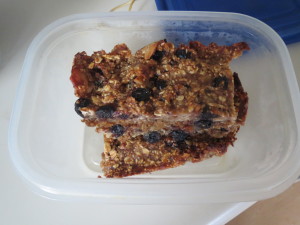Hi all,
Do you like figs but are not excited about fig newtons? Well, I have a solution for you! I have created a granola fig bar, which is easy to make incorporating the taste of figs!
Ingredients:
1 cup of dried figs
1 cup of oats
1/2 cup of sliced almonds
1/4 cup of dried blueberries or other fruit
Directions:
I first soak the dried figs overnight in water. The next day, I pour out the water and then put the figs into the food processor to make a paste out of the figs. Then, I put the fig paste into the mixer and continue to make a paste from the bananas and figs. You can make the rest without a food processor and manually mix the mixture instead, but it takes a lot longer to do that. Then, I add the oats and mix again. Finally, I add the almonds and mix. When everything is well mixed, I pour it into a pan (preferably stainless steel) lined with parchment paper (or you can use non-stick spray or oil, so the mixture does not stick). The mixture should be 1/4 inch thick. Then I bake it at 350 degrees fahrenheit for 30 minutes until the edges are brown. I cut it into small squares or rectangles to make bars once it cools.
Information about ingredients:
Figs: Figs are a good source of potassium, a mineral that helps to control blood pressure. Many people do not eat enough fruits and vegetables, and consume high amounts of sodium as salt, which is frequently added to processed foods and are deficient in potassium. Low intake of potassium-rich foods, coupled with a high intake of sodium, can lead to hypertension. In a study, one group ate servings of fruits and vegetables in place of snacks and sweets with a lower fat diet. Another group ate a “usual” diet low in fruits and vegetables with a similar fat content to the one found in the average American Diet. After eight weeks, the first group lowered their blood pressure more than the second group.(1)
Figs are also a good source of fiber. Results of a prospective study involving postmenopausal women showed a 34% reduction in breast cancer risk for those consuming the most fruit fiber compared to those consuming the least. Besides their potassium and fiber content, figs emerged from our food ranking system as a good source of the trace mineral manganese.(2)
Other considerations: Figs contain oxalates, which can become concentrated in body fluids and crystallize, causing stones. Therefore, individuals with already existing and untreated kidney or gallbladder problems may want to avoid figs.
Sulfur-containing compounds are preservatives added to dried foods like figs to prevent oxidation and bleaching of colors. The sulfites used to help preserve dried figs may cause adverse reactions. Foods that are classified as “organic” do not contain sulfites. This is another reason to buy organic!
Blueberries: Blueberries contain many antioxidants and anti-inflammatory compounds.(3) The cardiovascular system has strengthened antioxidant status following consumption of blueberries.(4) Damage to muscles following overly taxing exercise can be reduced through consumption of blueberries.(5) There is also evidence that consumption of blueberries can protect the nervous system from oxidative stress. These antioxidant-based protective effects have been shown in older adults at risk of neurodegenerative diseases. (6) Blueberries are a low glycemic index food. They also provide a very good amount of fiber (nearly 4 grams per cup). Low glycemic index foods with strong fiber content are foods are helpful in blood sugar regulation.(7) Antioxidant protection of the blood sugar regulatory system has also been demonstrated in blueberry intake studies, as has antioxidant protection against cancer. (8)
(1) Appel LJ, Moore TJ, Obarzanek E, et al. A clinical trial of the effects of dietary patterns on blood pressure. DASH Collaborative Research Group. N Engl J Med. 1997 Apr 17;336(16):1117-24. 1997.
(2) Suzuki R, Rylander-Rudqvist T, Ye W, et al. Dietary fiber intake and risk of postmenopausal breast cancer defined by estrogen and progesterone receptor status–a prospective cohort study among Swedish women. Int J Cancer. 2008 Jan 15;122(2):403-12. 2008. PMID:17764112.
(3) “Blueberries.” The World’s Healthiest Foods. The George Mateljan Foundation, Web. 01 September 2015 accessed. <whfoods.com/genpage.php?tname=foodspice&dbid=8>.
(4) Basu A, Du M, Leyva MJ et al. Blueberries Decrease Cardiovascular Risk Factors in Obese Men and Women with Metabolic Syndrome. The Journal of Nutrition. Bethesda: Sep 2010. Vol. 140, Iss. 9; p. 1582-1587. 2010.
(5) Hurst RD, Wells RW, Hurst SM et al. Blueberry fruit polyphenolics suppress oxidative stress-induced skeletal muscle cell damage in vitro. Mol Nutr Food Res. 2010 Mar;54(3):353-63. 2010.
(6) Krikorian R, Shidler MD, Nash TA et al. Blueberry Supplementation Improves Memory in Older Adults. J Agric Food Chem. 2010 April 14; 58(7): 3996-4000. 2010.
(7) Still AJ, Cash KC, Johnson WD et al. Bioactives in Blueberries Improve Insulin Sensitivity in Obese, Insulin-Resistant Men and Women. The Journal of Nutrition. Bethesda: Oct 2010. Vol. 140, Iss. 10; p. 1764-1768. 2010.
(8) Adams LS, Phung S, Yee N et al. Blueberry Phytochemicals Inhibit Growth and Metastatic Potential of MDA-MB-231 Breast Cancer Cells Through Modulation of the Phosphatidylinositol 3-Kinase Pathway. Cancer Res. 2010 May 1; 70(9): 3594-3605. Published online 2010 April 13. doi: 10.1158/0008-5472.CAN-09-3565. 2010.
Enjoy your snack knowing that you are eating something full of powerful anti-oxidants that is yummy too!!!
